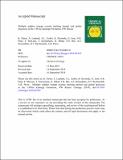Multiple sulphur isotope records tracking basinal and global processes in the 1.98 Ga Zaonega Formation, NW Russia
Abstract
The exceptionally organic-rich rocks of the 1.98 Ga Zaonega Formation deposited in the Onega Basin, NW Russia, have refined our understanding of Earth System evolution during the Paleoproterozoic rise in atmospheric oxygen. These rocks were formed in vent- or seep-influenced settings contemporaneous with voluminous mafic volcanism and contain strongly 13C-depleted organic matter. Here we report new isotopic (δ34S, Δ33S, Δ36S, δ13Corg) and mineralogical, major element, total sulphur and organic carbon data for the upper part of the Zaonega Formation, which was deposited shortly after the termination of the Lomagundi-Jatuli positive carbon isotope excursion. The data were collected on a recently obtained 102 m drill-core section and show a δ13Corg shift from −38‰ to −25‰. Sedimentary sulphides have δ34S values typically between +15‰ and +25‰ reflecting closed-system sulphur isotope behaviour driven by high rates of microbial sulphate reduction, high sulphate demand, hydrothermal activity and hydrocarbon seepage. Four intervals record δ34S values that exceed +30‰. We interpret these unusually 34S-enriched sulphides to be a result of limited sulphate diffusion into pore waters due to changes in sedimentation and/or periods of basinal restriction. Additionally, there are four negative δ34S and positive Δ33S excursions that are interpreted to reflect changes in the open/closed-system behaviour of sulphate reduction or availability of reactive iron. Our findings highlight the influence of basinal processes in regulating sulphur isotope records and the need for care before interpreting such signals as reflecting global conditions.
Citation
Paiste , K , Lepland , A , Zerkle , A L , Kirsimäe , K , Izon , G J , Patel , N , McLean , F , Kreitsmann , T , Mänd , K , Bui , T , Romashkin , A , Rychanchik , D & Prave , A R 2018 , ' Multiple sulphur isotope records tracking basinal and global processes in the 1.98 Ga Zaonega Formation, NW Russia ' , Chemical Geology , vol. 499 , pp. 151-164 . https://doi.org/10.1016/j.chemgeo.2018.09.025
Publication
Chemical Geology
Status
Peer reviewed
ISSN
0009-2541Type
Journal article
Description
A. L. Z. acknowledges support from a Natural Environment Council Standard Grant NE/J023485/2. G.Collections
Items in the St Andrews Research Repository are protected by copyright, with all rights reserved, unless otherwise indicated.

